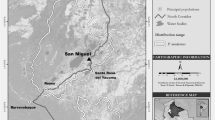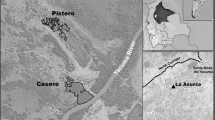Abstract
This paper describes the diet and range use patterns of the three species of primates in Santa Rosa National Park, Costa Rica (Ateles geoffroyi, Alouatta palliata, andCebus capucinus) and examines the variation in these variables as they relate to seasonal changes and concomitant changes in food availability. These three primate species were studied over a four-year period for a total of 24 months in the field. Santa Rosa National Park is in an area that experiences a long severe dry season in which little if any rain falls and the majority of the non-riparian trees lose their leaves. However, even though the three species were very flexible in terms of diet and range use, the behavioural variability did not correspond to changes in food availability or season.
Similar content being viewed by others
References
Altmann, S. A. &J. Altmann, 1970.Baboon Ecology. Univ. of Chicago Press, Chicago.
Baker, H. G., K. S. Bawa, G. W. Frankie, &P. A. Opler, 1982. Reproductive biology of plants in tropical forests. In:Ecosystems of the World: Tropical Forests,F. B. Golly &H. Leigh (eds.), Elsewier, Amsterdam, pp. 183–215.
Burt, W. H., 1943. Territoriality and home range concepts as applied to mammals.J. Mammal., 24: 346–352.
Buskirk, R. E. &W. H. Buskirk, 1976. Changes in arthropod abundance in a highland Costa Rica forest.Amer. Midland Natur., 95: 288–298.
Chivers, D. J., 1969. On the daily behaviour and spacing of howling monkey groups.Folia Primatol., 10: 48–102.
Clutton-Brock, T. H., 1974. Primate social organization and ecology.Nature, 250: 539–542.
, 1975. Ranging behaviour of red colobus (Colobus badius tephrosceles) in the Gombe National Park.Anim. Behav., 23: 706–722.
, 1977. Some aspects of intraspecific variation in feeding and ranging behaviour in primates. In:Primate Ecology,T. H. Clutton-Brock (ed.), Academic Press, London, pp. 539–556.
&P. H. Harvey, 1977. Species differences in feeding and ranging behaviour in primates. In:Primate Ecology,T. H. Clutton-Brock (ed.), Academic Press, London, pp. 557–579.
Daubenmire, R., 1972. Phenology and other characteristics of tropical semi-deciduous forests in Northwestern Costa Rica.J. Ecol., 60: 147–170.
Estrada, A., 1984. Resource use by the howler monkeys (Alouatta palliata) in the rain forest of Los Tuxtlas, Veracruz, Mexico.Int. J. Primatol., 5: 105–131.
Fedigan, L. M. &M. J. Baxter, 1984. Sex differences and social organization in free-ranging spider monkeys (Ateles geoffroyi).Primates, 25: 279–294.
,L. Fedigan, &C. A. Chapman, 1985. A census ofAlouatta palliata andCebus capucinus monkeys in Santa Rosa National Park, Costa Rica.Brenesia, 23: 309–322.
Fleming, T. H., C. F. Williams, F. J. Bonaccorso, &L. H. Herbst, 1985. Phenology, seed dispersal, and colonization inMuntingia calabura a neotropical pioneer tree.Amer. J. Bot., 72: 383–391.
Frankie, G. W., H. G. Baker, &P. A. Opler, 1974a. Comparative phenological studies of trees in tropical wet and dry forest in the lowlands of Costa Rica.J. Ecol., 62: 881–919.
, &, 1974b. Tropical phenology: Application for studies in community ecology. In:Phenology and Seasonality Modelling,H. Leigh (ed.), Springer-Verlag, Berlin, pp. 287–297.
Freeland, W. J., 1976. Pathogens and the evolution of primate sociality.Biotrop., 8: 12–24.
Gaulin, S. J. C. &C. K. Gaulin, 1982. Behavioural ecology ofAlouatta seniculus in Andean cloud forest.Int. J. Primatol., 3: 1–32.
,D. H. Knight, &C. K. Gaulin, 1980. Local variance inAlouatta group size and food availability on Barro Colorado Island.Biotrop., 12: 137–143.
Gautier-Hion, A., 1980. Seasonal variation of diet related to species and sex in a community ofCercopithecus monkeys.J. Anim. Ecol., 49: 237–269.
,L. H. Emmons, &G. Dubost, 1980. A comparison of the diets of three major groups of primary consumers of Gabon (primates, rodents, and ruminants).Oecologia, 45: 182–189.
Glander, K., 1980. Reproduction and population growth in free-ranging mantled howling monkeys.Amer. J. Phys. Anthropol., 53: 25–36.
----,L. M. Fedigan, L. Fedigan, & C. A. Chapman, in prep. Capture and marking monkeys in Santa Rosa National Park, Costa Rica.
Hamilton, W. J., 1982. Baboon sleeping site preferences and relationships to primate grouping patterns.Amer. J. Primatol., 3: 41–53.
Harrison, M. J. S., 1983. Patterns of range use by the green monkeyCercopithecus sabaeus, at Mt. Assirik, Senegal.Folia Primatol., 41: 157–179.
Herrera, C. M., 1985. Determinants of plant-animal coevolution: the case of mutualistic dispersal of seeds by vertebrates.Oikos, 44: 132–141.
Howe, H. F. &G. A. Estabrook, 1977. On interspecific competition for avian dispersers in tropical trees.Amer. Naturalist, 111: 817–832.
Janzen, D. H., 1973. Sweep samples of tropical foliage insects: effects of season, vegetation types, time of the day, and insularity.Ecology, 54: 687–708.
, 1986. Guanacaste National Park: Tropical, ecological, and cultural restoration. Editorial Univ. Estatal a Distancia, San Jose.
Kavanagh, M., 1981. Variable territoriality among tantalus monkeys in Cameroon.Folia Primatol., 36: 76–98.
Klein, L. L. &D. J. Klein, 1975. Social and ecological contrasts between four taxa of neotropical primates. In:Socioecology and Psychology of Primates,R. H. Tuttle (ed.), Mouton, Hague, pp. 59–85.
&, 1977. Feeding behaviour of the Colombian spider monkey. In:Primate Ecology,T. H. Clutton-Brock (ed.), Academic Press, London, pp. 153–181.
Kummer, H., 1968.Social Organization of Hamadryas Baboons. Univ. of Chicago Press, Chicago.
Leighton, M., 1982. Fruit resources and patterns of feeding, spacing, and grouping among sympatric Bornean hornbills (Bucerotidae). Unpubl. Ph.D. Dissertation. Univ. of California, Davis.
, &D. R. Leighton, 1982. The relationship of size of feeding aggregate to size of food patch: Howler monkey (Alouatta palliata) feeding inTrichilia cipo fruit trees on Barro Colorado Island.Biotrop., 14: 81–90.
MacKinnon, J. R. &K. S. MacKinnon, 1978. Comparative feeding ecology of six sympatric primates in West Malaysia.Rec. Adv. Primatol., 1: 305–321.
&, 1980. Niche differentiation in a primate community. In:Malayan Forest Primates,D. J. Chivers (ed.), Plenum Press, New York, pp. 167–190.
McDiarmid, R. W., R. E. Ricklefs, &M. S. Foster, 1977. Dispersal ofStemmadenia donnell-smithii (Apocynaceae) by birds.Biotrop., 9: 9–25.
McKey, D. &P. G. Waterman, 1982. Ranging behaviour of a group of black colobus (Colobus satanas) in the Douala-Eden Reserve, Cameroon.Folia Primatol., 39: 264–304.
Milton, K., 1980.The Foraging Strategy of Howler Monkeys. Columbia Univ. Press, New York.
&M. L. May, 1976. Body weight, diet and home range area in primates.Nature, 259: 459–462.
,D. Windsor, D. Morrison, &M. Estribi, 1982. Fruiting phenologies of two neotropicalFicus species.Ecology, 63: 752–762.
Mitani, J. C. &P. S. Rodman, 1979. Territoriality: the relation of ranging pattern and home range size to defendability, with an analysis of territoriality among primate species.Behav. Ecol. Sociobiol., 5: 241–251.
Opler, P. A., G. W. Frankie, &H. G. Baker, 1976. Rainfall as a factor in the release, timing and synchronization of anthesis by tropical trees and shrubs.J. Biogeog., 3: 231–236.
, &, 1980. Comparative phenological studies of shrubs and treelets in wet and dry forests in the lowlands of Costa Rica.J. Ecol., 68: 167–188.
Peters, R. H., S. Cloutier, D. Dube, E. Evans, P. Hastings, H. Kaiser, D. Kohn, &B. Sarwer-Foner, 1988. The allometry of the weight of fruit on trees and shrubs in Barbados.Oecologia, 74:612–616.
Pielou, E. C., 1969.An Introduction to Mathematical Ecology. Wiley, New York.
Raemaekers, J., 1980. Causes of variation between months in the distance traveled daily by gibbons.Folia Primatol., 34: 46–60.
Rasmussen, D. R., 1979. Correlates of patterns of range use of a troop of yellow baboons (Papio cynocephalus). I. Sleeping sites, impregnable females, births, and male emigrations and immigrations.Anim. Behav., 27: 1098–1112.
Richard A. F., 1985.Primates in Nature. W. H. Freeman & Co., New York.
Smith, C. C., 1977. Feeding behaviour and social organization in howling monkeys. In:Primate Ecology,T. H. Clutton-Brock (ed.), Academic Press, London, pp. 97–126.
Smythe, N., 1970. Relationships between fruiting seasons and seed dispersal methods in a Neotropical forest.Amer. Naturalist, 104: 25–35.
Sokal, R. R. &F. J. Rohlf, 1981.Biometry. W. H. Freeman & Co., San Francisco.
Struhsaker, T. T., 1978. Food habits of five monkey species in the Kibale forest, Uganda. In:Recent Advances in Primatology,D. J. Chivers &J. Herbert (eds.), Academic Press, New York, pp. 225–248.
Terborgh, J., 1983.Five New World Primates. A Study in Comparative Ecology. Princeton Univ. Press, Princeton.
Wrangham, R. W., 1981. Drinking competition in vervet monkeys.Anim. Behav., 29: 904–910.




